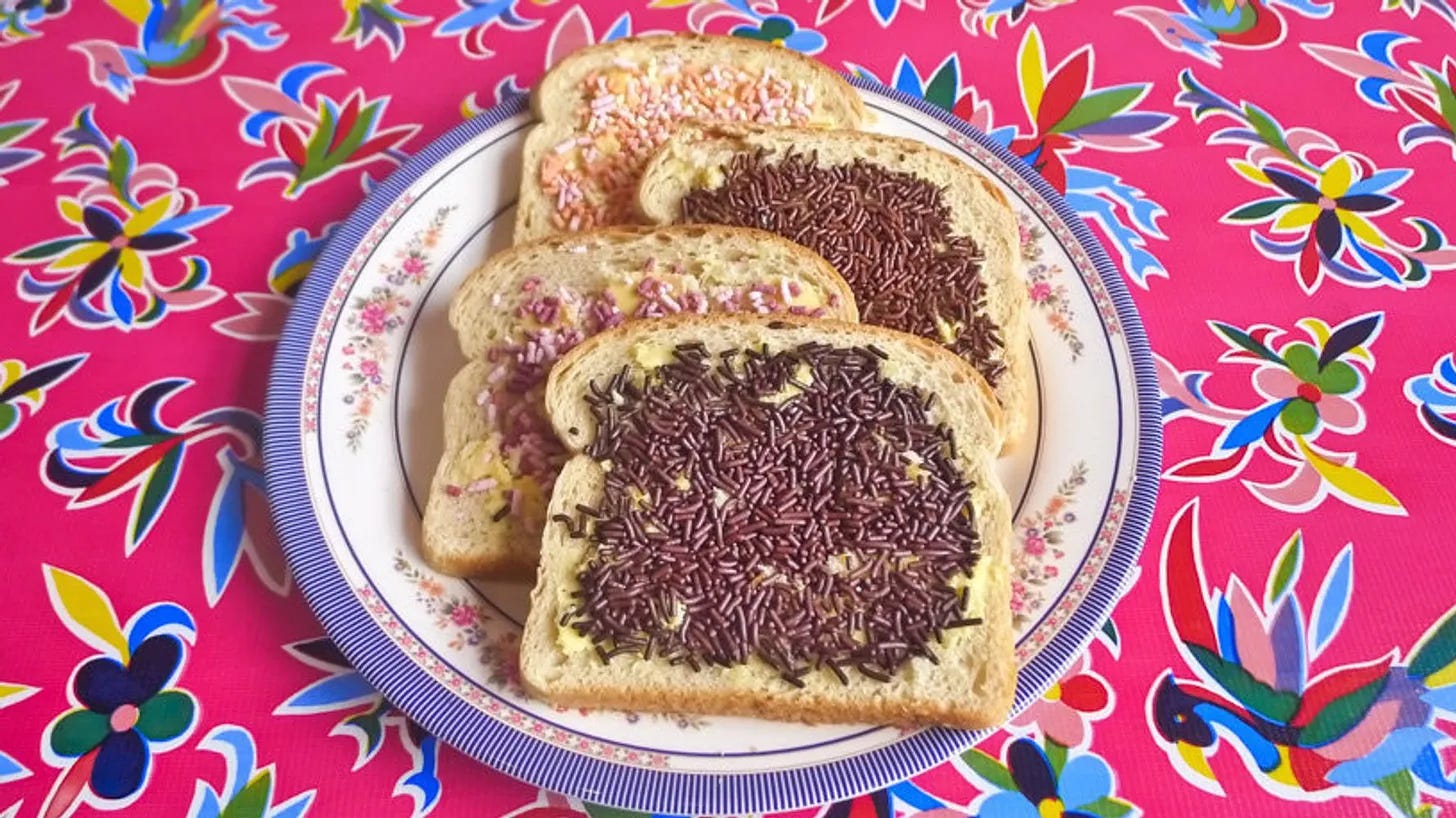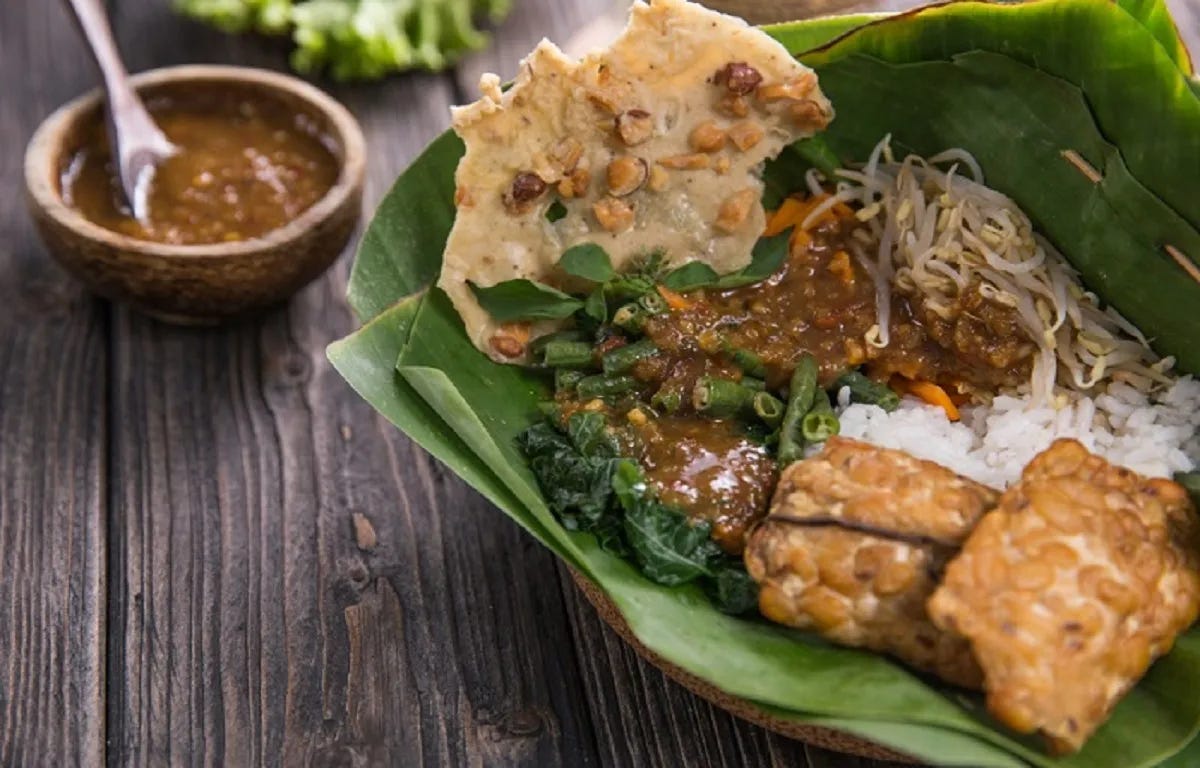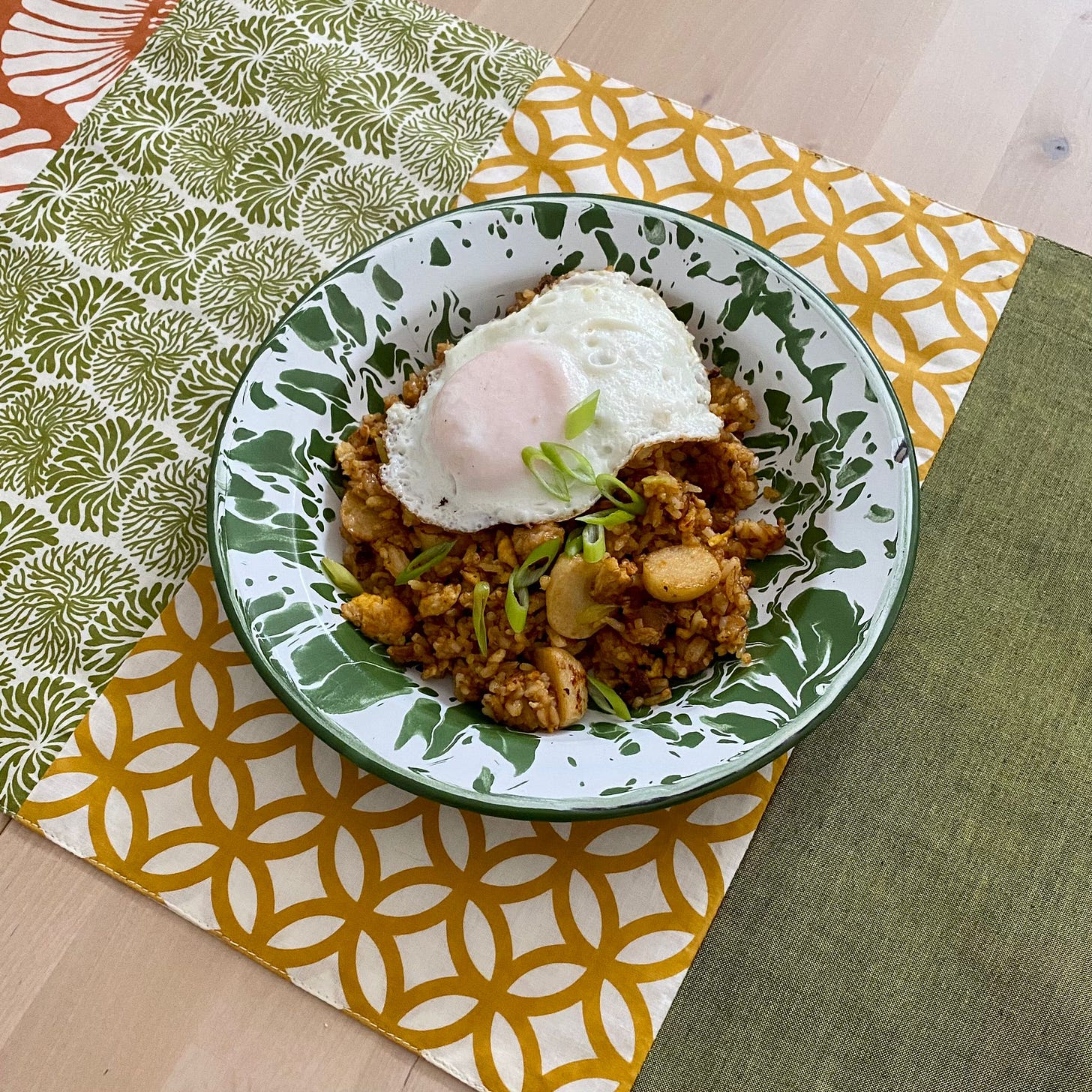Halo and Haaappy Monday!
I’m so excited to share today’s newsletter as this is Kepayang’s first-ever guest post. Let me introduce you to the author of this post —
from Mangan! When I first started thinking about collaborating with fellow writers on Substack, I knew that I wanted to have someone who shared the same passion for Indonesian food as me, and Aysha is just the right person for that! Writing from the Netherlands, Aysha shares her perspective of Indonesian food through her lens as an Indonesian and shares histories of Indonesian food - with stories and recipes from her own family, recent trips, or random moments from her life because she just wanted to.If you enjoy eating jajan pasar, exploring new places and foods, or romanticising your days through cooking staple dishes like sambal tempe penyet, Mangan is the perfect newsletter for you.
In this post, Aysha will share about:
🌏 The wide range of breakfast served in Indonesia and their interesting origins
🍚 How nasi goreng (fried rice) became one of Indonesia’s national dishes through its versatility across the regions
🍳 Her mom’s nasi goreng’s recipe!
“What’s the typical Indonesian breakfast?” my Dutch colleague at the office asked me the other day. That may seem like a simple question, yet I found myself thinking hard about the answer. All I could think of was nasi goreng (fried rice), bubur ayam (chicken porridge), or mie ayam (chicken noodles). Remembering my childhood days in Jakarta, I did not grow up eating the “typical” breakfast dishes such as nasi goreng or bubur ayam. I occasionally had these or sego pecel (Javanese ‘salad’ in peanut sauce) on the weekends. Instead, I grew up eating white bread with meses a.k.a the chocolate sprinkle a.k.a the Dutch hagelslag. This surprised my Dutch colleagues a lot.
In December last year, I went home to Indonesia for the Christmas holiday. I then recalled all the breakfasts I had during my recent trip home. One thing I realized was that my breakfast choice changes almost every day. Since I had the luxury of time during this trip, I got to indulge the street food to start my day. One day I had jajan pasar (Indonesian traditional snacks), and the other days I had siomay (steamed fish dumplings with vegetables in peanut sauce), or a bowl of soto mie (beef noodle soup). So, is there really a typical Indonesian breakfast?
The diversity of Indonesian breakfast.
As a child, my preferred way to enjoy meses was by scattering them between two slices of buttered bread, closing the sandwich, and swiftly dipping it into cold chocolate milk. The dipping had to be done swiftly to prevent the bread from becoming too soggy. I loved it when the sprinkles fell out from the bread and submerged at the bottom of the chocolate milk, creating an extra treat with the last gulp. When I moved to the Netherlands, I realized that my international friends were surprised that Dutch people eat chocolate for breakfast. They wondered how Dutch children managed to avoid a sugar rush before heading to school. Reflecting on my own upbringing, where chocolate sprinkles for breakfast were the norm, I couldn't comprehend why this wasn't considered commonplace. And in that moment I realized that this tradition was likely influenced by Dutch culinary customs.
Indonesia is a country rich in history, and cultural and religious diversity. As a nation with a population of over 270 million people, the archipelago encompasses a wide range of ethnic groups and religions. This is clearly reflected in the diversity of our cuisine. For breakfast, you can find bubur Manado, a savory Manadonese porridge paired with corn, sweet potato, and smoked skipjack tuna in Manado, North Sulawesi. Moving to West Java, batagor, fried fish dumplings served with peanut sauce, takes center stage. In Java, sego pecel, a Javanese ‘salad’ with peanut sauce, is a breakfast staple. Across different regions of Java, variations of sego pecel adopt distinct local flavors — sweeter in Central Java and more savory in East Java. As the paternal side of my family originally came from East Java, sego pecel is a weekend brunch staple in my household.
A special shoutout to Pecel Pincuk Ibu Ida in Bintaro which has been my family’s personal favorite for years. If you ever visit there, a tip from me is to get the medium spicy peanut sauce with additional tempe mendoan (fried tempe in half-cooked batter) and Indonesian fried chicken as the mandatory toppings.
Nasi goreng — a melting pot of flavors, a melting pot of culture.
“When I visited Indonesia, I remember I had nasi goreng (Indonesian fried rice) every day for breakfast.” said my other Dutch colleague. While there is not a single “typical” breakfast for the entire nation, nasi goreng is commonly enjoyed in the morning. A popular and versatile dish, the Indonesian nasi goreng is fried rice often cooked with kecap manis (sweet soy sauce), shallots, garlic, chili, and accompanied by ingredients like fried eggs, prawns, or chicken. It allows for the incorporation of leftovers from the previous day, making it a convenient and efficient choice for breakfast. Though nasi goreng is a simple dish, it has deep cultural roots in Indonesia. It has been influenced by Chinese culinary traditions. The cooking method of stir-frying, commonly used in Chinese cuisine, is integral to the preparation of nasi goreng. The use of a wok is also often used in the preparation of the dish. We adopted the Chinese tradition coming from a place of scarcity and practical need. It is a belief that it is sinful to waste food and like many other versions of fried rice, nasi goreng was created.
Though there is no single defined recipe for nasi goreng, as every dish has different toppings and mixtures, there is a variety of fried rice recipes across the country. The most common nasi goreng is cooked with ample amounts of kecap manis (sweet soy sauce) that creates a golden, brown-ish color, with a hint of sweetness. This is what we call the typical nasi goreng kampung (kampung means “village” in Indonesian and Malay). However, in other parts such as Sulawesi, the sweet soy sauce is usually absent and replaced with bottled tomato ketchup and chili sauce. This is called nasi goreng merah, which is translated to red fried rice. Some variants of nasi goreng in Medan, North Sumatra, use salted fish and do not use sweet soy sauce, thus, creating a lighter color resembling the Chinese or Japanese fried rice. What I found interesting is nasi goreng Aceh from Aceh, Northwest Sumatra, that shares similarities to Middle Eastern cuisine. The flavor is much more pungent with spices such as cinnamon and coriander. The spices combined in Acehnese cuisine are commonly found in Indian and Arab cuisine, such as cumin, cloves, cinnamon, cardamom, and fennel. This is due to Arab, Persian, and Indian traders that strongly influenced the food in Aceh although flavours have substantially changed their original forms. It’s safe to say that the nasi goreng from Aceh is the epitome of a melting pot of different cultures.

While nasi goreng has made it as one of the country’s national dishes along with rendang (slow-cooked meat braised in coconut milk and herbs), gado gado (boiled, blanched, or steamed vegetables with peanut sauce), and sate (skewered and barbecued meat), nasi goreng is a staple of Indonesian cuisine. Not only because it’s easy and anyone can find it across the country, it is an excellent example of the culinary diversity of Indonesia with each region putting its unique and local twist on the recipe.
My mom’s nasi goreng recipe.
As I told you earlier, I did not grow up eating nasi goreng for breakfast. But on some occasions, like on a laid-back weekend, my mom used to whip up some nasi goreng. Her version uses a very minimal sweet soy sauce. Feel free to try and make your own twist with whatever you can find in your fridge!
Ingredients:
A portion of a day-old jasmine rice
3 cloves of garlic
3 Asian shallots or 1 banana shallot
2 candlenuts (optional)
1 bird-eye chili
2 tbsp water
1/4 tsp shrimp paste (terasi)
1/2 tbsp sweet soy sauce
A dollop of tomato ketchup
Two eggs
1 scallion
Salt and pepper
Vegetable oil
Steps:
Blend garlic, shallot, candlenuts, chili, and water in a food processor until almost smooth. Fry the blend in a medium heat wok pan. Stir fry until the spices turn brownish and fragrant. Add the shrimp paste and continue stirring.
Add one beaten egg into the spices.
Add rice to the mixture. Drizzle the sweet soy sauce and a dollop of tomato ketchup. Stir fry until all spices and sauces are well combined into the rice.
Add the white part of the scallions along with salt and pepper. Continue stir-frying. Don’t forget to taste as you cook! Then set aside your fried rice into your plate.
With the same wok pan (because ✨FLAVORS✨), add a drizzle of oil and make a sunny side up.
Serve your sunny side up on top of the rice with a sprinkle of the green part of the scallion.
Tips:
Always, always, always, use day-old rice to make fried rice to get the best texture. You don’t want your fried rice to be fluffy and sticky (or pulen in Bahasa Indonesia). Using freshly cooked rice for fried rice should be a crime.
The shrimp paste is optional but it guarantees ✨umaminess✨ to your dish. If you don’t have it or have a plant-based diet, adjust the salt at the end.
Vegetables like carrots and peas go really well in fried rice. If you have these, make sure to add the vegetables first before the rice.
Selamat makan! Enjoy!
If you like today’s newsletter, please like and share it with your friends! Comment down below your thoughts and don’t forget to subscribe to
and follow Mangan’s Instagram here.Let me know if you have any other topics you want me to discuss. Until then, I’ll see you in two weeks!
Follow me everywhere:
TikTok: @berusahavegan
Kepayang’s Instagram: @readkepayang
Instagram: @menggemaskan
LinkedIn: Chalafabia Haris
Work with me: readkepayang@gmail.com









